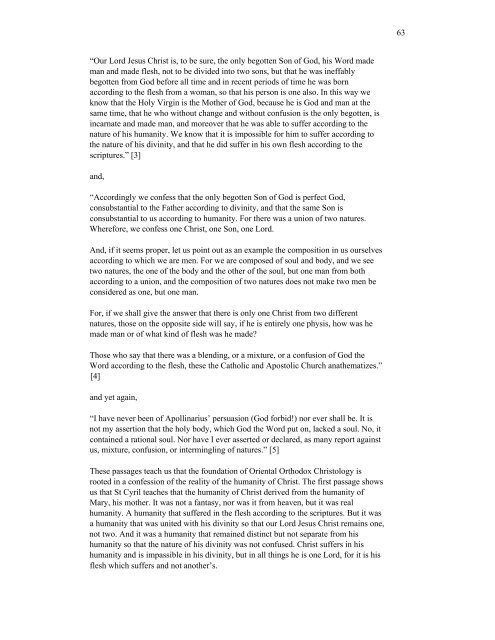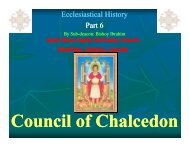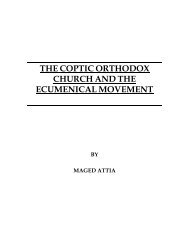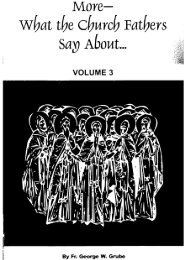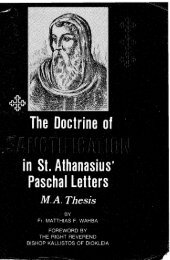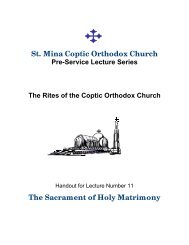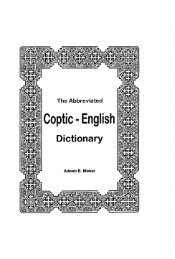Coptic interpretations of the Fourth Ecumenical Council - Saint Mina ...
Coptic interpretations of the Fourth Ecumenical Council - Saint Mina ...
Coptic interpretations of the Fourth Ecumenical Council - Saint Mina ...
You also want an ePaper? Increase the reach of your titles
YUMPU automatically turns print PDFs into web optimized ePapers that Google loves.
“Our Lord Jesus Christ is, to be sure, <strong>the</strong> only begotten Son <strong>of</strong> God, his Word made<br />
man and made flesh, not to be divided into two sons, but that he was ineffably<br />
begotten from God before all time and in recent periods <strong>of</strong> time he was born<br />
according to <strong>the</strong> flesh from a woman, so that his person is one also. In this way we<br />
know that <strong>the</strong> Holy Virgin is <strong>the</strong> Mo<strong>the</strong>r <strong>of</strong> God, because he is God and man at <strong>the</strong><br />
same time, that he who without change and without confusion is <strong>the</strong> only begotten, is<br />
incarnate and made man, and moreover that he was able to suffer according to <strong>the</strong><br />
nature <strong>of</strong> his humanity. We know that it is impossible for him to suffer according to<br />
<strong>the</strong> nature <strong>of</strong> his divinity, and that he did suffer in his own flesh according to <strong>the</strong><br />
scriptures.” [3]<br />
and,<br />
“Accordingly we confess that <strong>the</strong> only begotten Son <strong>of</strong> God is perfect God,<br />
consubstantial to <strong>the</strong> Fa<strong>the</strong>r according to divinity, and that <strong>the</strong> same Son is<br />
consubstantial to us according to humanity. For <strong>the</strong>re was a union <strong>of</strong> two natures.<br />
Wherefore, we confess one Christ, one Son, one Lord.<br />
And, if it seems proper, let us point out as an example <strong>the</strong> composition in us ourselves<br />
according to which we are men. For we are composed <strong>of</strong> soul and body, and we see<br />
two natures, <strong>the</strong> one <strong>of</strong> <strong>the</strong> body and <strong>the</strong> o<strong>the</strong>r <strong>of</strong> <strong>the</strong> soul, but one man from both<br />
according to a union, and <strong>the</strong> composition <strong>of</strong> two natures does not make two men be<br />
considered as one, but one man.<br />
For, if we shall give <strong>the</strong> answer that <strong>the</strong>re is only one Christ from two different<br />
natures, those on <strong>the</strong> opposite side will say, if he is entirely one physis, how was he<br />
made man or <strong>of</strong> what kind <strong>of</strong> flesh was he made?<br />
Those who say that <strong>the</strong>re was a blending, or a mixture, or a confusion <strong>of</strong> God <strong>the</strong><br />
Word according to <strong>the</strong> flesh, <strong>the</strong>se <strong>the</strong> Catholic and Apostolic Church ana<strong>the</strong>matizes.”<br />
[4]<br />
and yet again,<br />
“I have never been <strong>of</strong> Apollinarius’ persuasion (God forbid!) nor ever shall be. It is<br />
not my assertion that <strong>the</strong> holy body, which God <strong>the</strong> Word put on, lacked a soul. No, it<br />
contained a rational soul. Nor have I ever asserted or declared, as many report against<br />
us, mixture, confusion, or intermingling <strong>of</strong> natures.” [5]<br />
These passages teach us that <strong>the</strong> foundation <strong>of</strong> Oriental Orthodox Christology is<br />
rooted in a confession <strong>of</strong> <strong>the</strong> reality <strong>of</strong> <strong>the</strong> humanity <strong>of</strong> Christ. The first passage shows<br />
us that St Cyril teaches that <strong>the</strong> humanity <strong>of</strong> Christ derived from <strong>the</strong> humanity <strong>of</strong><br />
Mary, his mo<strong>the</strong>r. It was not a fantasy, nor was it from heaven, but it was real<br />
humanity. A humanity that suffered in <strong>the</strong> flesh according to <strong>the</strong> scriptures. But it was<br />
a humanity that was united with his divinity so that our Lord Jesus Christ remains one,<br />
not two. And it was a humanity that remained distinct but not separate from his<br />
humanity so that <strong>the</strong> nature <strong>of</strong> his divinity was not confused. Christ suffers in his<br />
humanity and is impassible in his divinity, but in all things he is one Lord, for it is his<br />
flesh which suffers and not ano<strong>the</strong>r’s.<br />
63


